Today, of course, digital cameras have supplanted film cameras almost completely, although film is still used by a small number of enthusiasts.
Just before the era of the digital camera, electronic still cameras using video technology were made, such as the SONY ProMavica series of cameras. These had CCD sensors similar to those in video cameras, and recorded an analog video signal on 2-inch floppy disks.
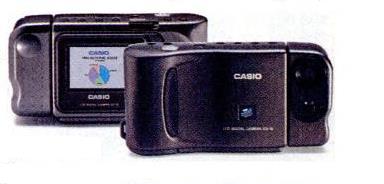
In 1995, the Casio QV-10, shown at left, became available. It took pictures with a 320 by 240 resolution, and cost somewhere under $1,000. This was the first digital camera that might be considered to have been accessible to the consumer, but film wasn't quite on the way out yet, with that being the best competition digital could muster.
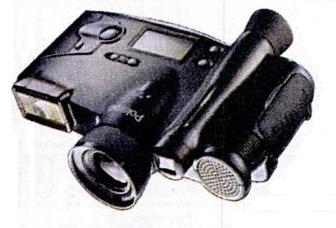
Polaroid, being the company associated with instant photography, realized that nothing could be more instant than a digital image, and made sure to enter the field early; the Polaroid PDC-2000, shown at right, was available in 1996.
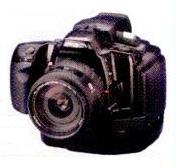
As I've noted elsewhere, due to semiconductor yield issues, large image sensors were very expensive, which is why so many digital cameras used APS-C size sensors, or sensors that were even smaller. Minolta decided to address this problem in a unique way.
The Minolta Dimage RD-3000 camera from 1998 contained an optical system that split the image into two parts, each part going to a different sensor. And the Minolta RD-175, which was introduced in 1995, and which is shown at left, used three sensors in order to provide a reasonable sensor size (still smaller than full frame) at an affordable price.
The Minolta Dimage RD-3000 simply used two conventional sensors to each cover half of the area of the picture.
The arrangement of the earlier RD-175, which was Minolta's first DSLR, was more complicated. All three sensors used were 768 by 512 pixel sensors. The image was split between two of those sensors, each of which recorded half of the green component of the image, and it was also reduced further so that the entire image also went to the third sensor, with a checkerboard filter pattern to handle red and blue. Thus, while in an ordinary Bayer-pattern camera, red and blue have half the resolution of green, here red and blue have about one-quarter the resolution of green.
I say "about" because 1024 by 768 pixels imply a 4:3 aspect ratio, while 768 by 512 pixels provide a 3:2 aspect ratio. As well, there was overlap between the two sensors in the RD-3000. So an anamorphic element could have been used in the optical path for the two sensors handling green (or, alternatively, a half-pixel diagonal offset could have been used for the two green sensors instead of splitting the image, thus avoiding the aspect ratio issue; but I'm doubtful that it would have been possible to align those two sensors with the level of precision that would require).
One source gives the resolution of the RD-175 as 1,528 by 1,166 pixels. That exceeds the pixel count of all three sensors, being 1,781,648 pixels, and each sensor having 393,216 pixels for a total of 1,179,648 pixels.
Video cameras sometimes used three black-and-white CCD sensors in conjunction with a dichroic mirror; this hearkens back to the earliest attempts at color photography, but although cameras with dichroic mirrors and three unfiltered sensors are still being made, these are for specialized applications.
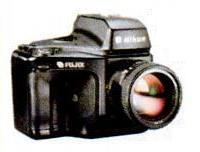
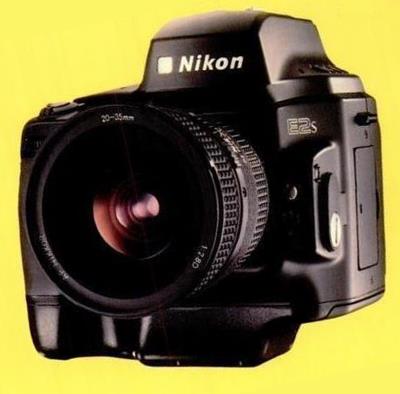
The Fujix DS 505, shown at left, also sold as the Nikon E2, dealt with the sensor size problem in a much simpler fashion, having additional lenses within the camera to shrink the full-frame image down to fit the sensor. This is quite an early digital camera, dating from 1995. Its resolution is given as 1,280 by 1,000 however; so the effective sensor size presumably would be less than 36mm wide due to the aspect ratio being less than 3:2. Sucessors to this camera, also having what Nikon termed the Reduction Optics System, were made: the Fujix DS-515, DS-505A, DS-515A, DS-560, and DS-565, which were also sold as the Nikon E2S, E2N, E2NS, E3 and E3S respectively.
As I was able to find a high-quality image of the Nikon E2S, that image is shown at right.
Why wasn't this always done, instead of coping with the annoyance that sensors on most digital cameras were smaller than the frame size on 35mm film? One main reason is that camera lenses tend to be of very high optical quality, and an additional lens system in the camera would place a limit on the benefits that would bring. The DS 505 was a very early digital camera, and so it used a sensor that was smaller than those which were found adequate to be used on later digital cameras: specifically, it used a 2/3" sensor, and one source states that 2/3" sensors with a 5:4 aspect ratio, which this sensor approximated, are 9.05mm by 5.66mm in size. So instead of a preferred option, lenses to shrink the image to fit the sensor were a last resort.
However, this idea is not dead.
You may have heard of a Kickstarter campaign for a Rspberry Pi-based device that had a main part shaped like a 35mm cartridge, with a circuit board extending from it containing a four-thirds image sensor. This item is still available, now on a regular basis, from the firm of "I'm Back" at this site as the "I'm Back Film".
But they also have available the "I'm Back 35" which replaces the back of a 35mm film camera; this uses a two-thirds sensor and an optical sysem which avoids a crop factor; it is slightly cheaper than the I'm Back Film module as well.
So you can use this with, say, a Nikon F4, and finally nhave a full-frame DSLR with an interchangeable pentaprism and a modern pixel count!
Some links on the site are for the Kickstarter campaign, which is now over, rather than the current continuous availability of the items; also one link for the "I'm Back 35" heads to a page about a small digital camera, with an associated page for the "I'm Back System" going to the page for the digital back I'm referring to, but the links for ordering and the content of the page at that link refer to the digital back as the "I'm Back 35".
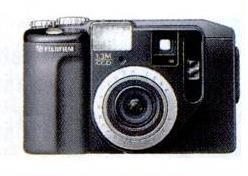
Incidentally, these cameras are now quite rare, and command very high prices on the used market. The same 1,280 by 1,000 pixel sensor was used on the Fujix DS-300, which simply had a built-in lens, and that camera is available much more cheaply. Shown at left is the Fujix DS-330, which is similar and also used the same sensor.
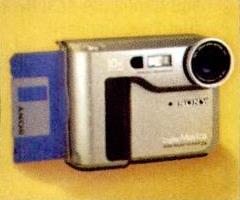
Perhaps in order that the name "SONY" on the floppy disk would be visible, it's shown inserted the wrong way around in the image at left of one model of the SONY Digital Mavica camera. Instead of worrying about the limited memory capacity of the camera, you could take as many floppy disks as you wanted with you when taking photographs! These cameras were available from around 1997.
It seemed like a good idea to me at the time, as the first digital camera I owned was one of SONY's floppy-disk based Mavica cameras. The picture of the Edmonton skyline that acts as the header for my home page was shot with it. I don't remember the exact model I owned, but it could have been the MVC-FD85.
By 1999, digital cameras with a 2.5 megapixel resolution were available, such as the Olympus C-2500L, a digital SLR, and started to be considered as comparable to film cameras. But it would be a few more years before the prices of digital cameras came down enough, and the capabilities of digital cameras improved enough, to drive film cameras from the market. Introductions of new film cameras from major camera makers started to taper off, and by 2004 hardly any such introductions were taking place. However, in 2005, a medium format digital camera would cost $10,000 or more, and so photographers using that format for higher resolution would have mostly continued with film for a few years yet.
One watershed, but not necessarily one of the most important ones, was the availability of digital cameras with full-frame sensors. The Contax N Digital, announced in 2000, and brought to market in 2002, with 6 megapixel resolution, was the first full-frame DSLR. (The Pentax MZ-D, with the same sensor from Philips, was announced before it, but was apparently cancelled before being brought to market.)

The Canon EOS-1Ds, pictured at left, had an 11.1 megapixel sensor, and despite a price of $7,000 was quite successful after being brought out in September 2002. The Kodak DCS Pro 14n was also a full-frame DSLR; it reached the market in May 2003, at a price of $5,000 and a resolution of 13.89 megapixels. One source credits the Canon EOS-1Ds, released on September 24, 2022 with being the digital camera that overcame the reservations of professional photographers towards the capability of digital cameras, thus marking the watershed moment in the transition to digital.
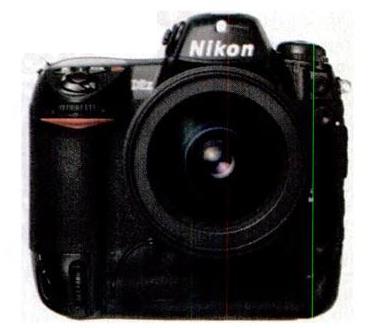
Another candidate for a watershed moment would be almost two years later, September 16, 2004, when Nikon announced both the Nikon F6 and the Nikon D2X. The D2X was not full-frame, but that didn't stop it from being Nikon's flagship camera for professionals; the Nikon F5 had held the same status, but the Nikon F6 was instead aimed at the advanced amateur.
The Nikon D2X had a 12.4 megapixel sensor. It could take photographs at a rate of five frames per second; but as a camera intended for professional photographers, it also offered a way of taking photographs at a rate of eight frames per second, by allowing the photographer to switch to a reduced resolution of 7 megapixels. This was an important feature; one of the major differences between the professional Nikon D3, and the advanced amateur D700 was that the D3 allowed one to take nine frames per second, while the D700 was limited to five frames per second (in other respects, since the Nikon D700 was a somewhat later camera, and both cameras are full-frame, and sell for about the same low prices on the used market, the D700 is recommended as the better choice for anyone not intending to get into serious sports photography).
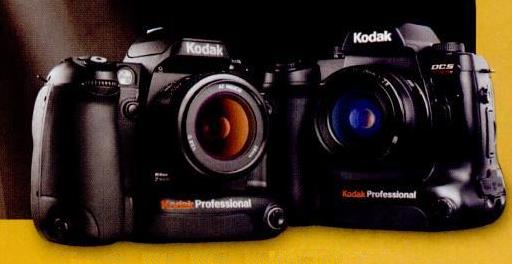
The Kodak DCS Pro 14n was built around a Nikon F80 body, not a Nikon F5 body like some earlier Kodak DSLRs. Or, rather, a Nikon N80 body, since that was the designation that film camera had when sold in the United States. This camera did not have a removable pentaprism.
Shown at left, as usual from an advertisement, are the digital cameras from Kodak belonging to the next generation; the DCS Pro SLR/n and the DCS Pro SLR/c - the former being built around a Nikon body, and the latter being built around a Canon body.
Since film definitely has its merits, the transition was much more gradual than that from the slide rule to the pocket calculator. For the mass market, eliminating the cost of film was a decisive factor once digital cameras became affordable; professional photographers, on the other hand, needed digital cameras to reach a high level of quality before they were "good enough".
And, as noted, film cameras are also still being used by some dedicated enthusiasts. By 2006, major film makers had started to discontinue a few of their film stocks, but a limited selection of film types are readily available, and film processing can also still be secured.
But the digital camera has experienced its own issues. In 2010, sales of digital cameras reached a peak, from which they precipitously delined as people who would have purchased lower-end cameras were instead satisfied with the capabilities of the cameras... built into their smartphones.
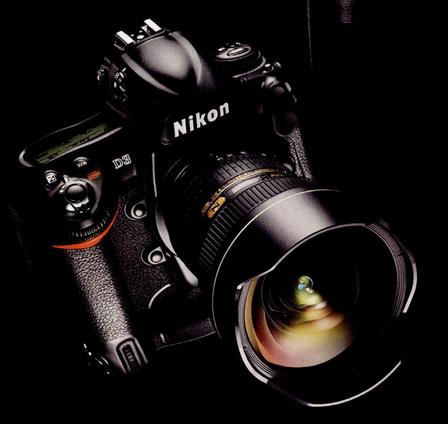
Pictured at right is an example of a digital DSLR. This camera, the Nikon D3, was well-regarded when it was first available, and was an expensive top-of-the-line camera when introduced, but is now available relatively inexpensively on the second-hand market, despite having a full-frame sensor (even if that sensor has "only" 12.1 megapixels).
Announced in 2007, it was the first camera with a full-frame sensor that Nikon offered.
While it doesn't offer as high a rate of taking photos in quick succession, the otherwise very closely related D700, also full-frame, is recommended as being preferable for most people. But the Canon 5D, while having a more awkward user interface, is said to take better-looking pictures. The Canon 5D had a resolution of 12.7 megapixels, making it comparable to the Nikon cameras mentioned, but at the same time, Canon also had available its EOS-1Ds Mark III, with a 21.1 megapixel sensor.
Although Canon cameras don't have the large flange-to-film sistance of Nikon cameras, they're still not ideally suited to the use of M42 screw mount lenses with an adapter; the mirror would collide with such a lens. There now is a full-frame sensor DSLR that is suitable for this purpose, as it uses K-mount lenses; the Pentax K-1. This, however, is a 36.4 megapixel camera from 2016, so it has not yet descended to really low prices on the used market.
Oh, silly me. This is not an unsolved problem. If a Canon DSLR doesn't quite fill the bill, while mirrorless cameras are more expensive on the used market than some full-frame DSLRs, there are now a few full-frame mirrorless cameras available used for considerably less than the price of a Pentax K-1 on the used market.
Actually, though, there is one big drawback to trying this approach. M42 screw-mount lenses aren't going to be equipped to make use of the autofocus feature of a mirrorless camera - and while the digital display on the camera lets you compose shots just as you would with a DSLR, it doesn't really provide the information needed for manually focusing the lens well enough to obtain sharp photographs.
Is somebody going to make an M42 to mirrorless adapter that also includes a tiny reflex mirror... and a focusing screen with a split-image zone in the center? I don't think so.
The Nikon D700, however, is apparently no slouch in the department of picture color quality, even if the 5D is reputed as being better. One source claimed its sensor was made by Panasonic; another says Nikon itself designed the sensor, although it did hire a foundry to actually manufacture it; that source cites another site as its source, and it notes they made the observation that there were structural similarities between this sensor and Panasonic sensors.
The sensor of the Nikon D700 has the part number designation NC81338L. However, since Nikon didn't sell sensors, only put them in its own cameras, unlike the case for some Kodak sensors, I haven't been able to find technical documentation on it. One site did note that the difference between this sensor and ones found on later Nikon cameras was that the dyes in the color filter matrix were narrower in the frequenies they let through, with less overlap. As this characteristic tends to make monochromatic light of some different wavelengths impossible to distinguish, I would think that overlapping curves are better, even if later processing is required to maintain the level of saturation.
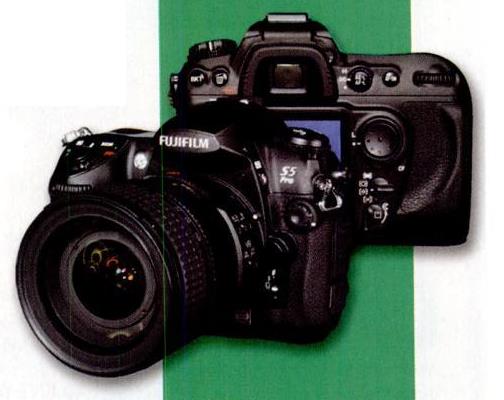
The Nikon D200 was an earlier Nikon camera, with a sensor in the Nikon DX format, which was 23.6mm by 15.8mm in size. Note that this is smaller than APS size, 30.2 mm by 16.7mm, but larger than four-thirds size at 17.6mm by 13.2mm. A sensor that was 23mm by 15.5mm in size was used in the Fujifilm Finepix S5 Pro camera, pictured at left; this camera used Nikon-mount lenses because it used the body of the Nikon D200 (although it used different batteries). It was one of the Fujifilm cameras that had a SuperCCD sensor with large octagonal pixels with small square pixels between them, for extra dynamic range.
As one review of a Fujifilm camera with a SuperCCD camera noted, the effective resolution of such a camera is determined solely by the large octagonal pixels, with the small square pixels simply being used to improve the rendering of bright areas in the image. That may have been the fault that led Fujifilm to abandon this sensor type.
Incidentally, the later Nikon D600, D700, and D800 cameras used full-frame sensors.
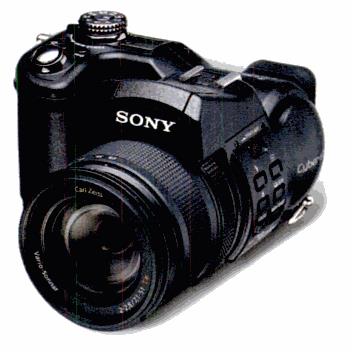
The Fujifilm SuperCCD sensor was one of the few attempts to replace the standard Bayer sensor used in most cameras with something innovative. Another attempt, which seems to have been less successful, appeared in only one model of camera, the SONY Cyber-Shot DSC-F828, shown at right. This replaced one of the green pixels in the Bayer array with a pixel having a different sensitivity, using a different shade of green, termed "Emerald".
One web site with a review of this camera showed a picture of some Crayola crayons in which the red crayon and the orange crayon were both red! The presence of emerald-filtered pixels in addition to red, green, and blue filtered pixels ought not to make the reproduction of reds and oranges inferior to that of cameras without the additional color, since a new color only adds information, not removing any (except for reducing the spatial resolution of green) so I would blame the image creation program in the camera; perhaps a firmware update could set it right?
Another source, however, claims that the F828 generally did have more accurate colors than other digital cameras. It also noted that the camera had a Standard mode and a Real mode. In Real mode, the camera did its best to reproduce colors accurately; in Standard mode, although it still made use of the additional information from the Emerald pixels, the camera attempted to produce pictures that wre not too different in appearance from those of other conventional digital cameras.
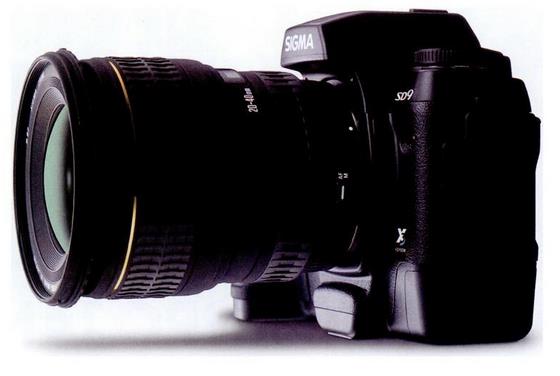
Of course, if we're going to talk about innovation in digital camera sensors, we can't fail to mention the one that was most profoundly innovative of all. That was the Foveon sensor, and the Sigma SD9 camera, pictured at right, is one of those that used it.
Ordinary camera sensors have one layer of cells sensitive to light, with a patterned array of color filters overtop. The Foveon sensor, instead, has a chip which has three layers of photosensitive cells, and the silicon which separates those layers also filters the light that reaches them, so that there are three classes of light detector with different spectral sensitivities, but each pixel has a sensor of each of the three kinds.
This eliminates the need to use interpolation to determine the values of the color components at a pixel location other than that pixel's native color component.
Of course, the real goal is to secure accurate and attractive color rendition, not to use a novel or impressive technology as the means of obtaining it.
We've seen above that among film stocks, Kodachrome was famed for having the best color reproduction.
Fujifilm digital cameras include among their options a number of "film simulations", including one presumed to be for Kodachrome film, and one for their own Velvia film which gives saturated colors.
While apparently CMOS sensor technology has improved so that recent cameras with CMOS sensors are as good as cameras with CCD sensors with respect to color quality, this was not originally true. However, Panasonic made a line of sensors, called Live MOS sensors, which were NMOS sensors. These were advertised as offering the image quality of CCD and the low power consumption of CMOS. Many people have praised the quality of the colors in images from cameras with Live MOS sensors, and such cameras offered features such as live preview that CCD cameras could not, so these claims appear to be true. (NMOS logic gates, of course, consume more power than CMOS logic gates, but an image sensor is not chiefly composed of logic gates, so the claim isn't obviously false for that reason.)
I have recently encountered a series of videos on YouTube in which it is noted that many early digital cameras used CCD sensors made by Kodak... and, in addition, that Kodak, as part of their effort to produce the best CCD sensors possible, chose the dyes that colored the squares of their Bayer arrays... so as to cause these cameras to produce images resembling those of Kodachrome film!
I was astonished by this, as this implied that the Holy Grail of digital photography not only had in fact been achieved, but was achieved in cameras that are now available quite inexpensively on the used market. Some of the cameras with such sensors are the Olympus E-300 and E-500, the Nikon D50, D70, D100, and D200, but there are several others. (I have since learned, though, that the sensor in the Nikon D200 was made by Sony, not Kodak.)
Given that Kodachrome film is no longer being produced, and 35mm film and its processing are expensive and hard to obtain these days, I feel this is very exciting news to photographers who feel that digital cameras lack something when compared to film, and can tolerate the lower pixel count and more limited features of older cameras.
(My web hosting service has a rule against including multimedia content, or links to multimedia content, in web sites hosted on it, presumably to reduce the risk of liability for copyright infringement; this is why I'm unable to provide a link to the series of videos I am mentioning here.)
This column or blog entry even misattributes the Live MOS sensors to Kodak instead of Panasonic, claiming that they, too, have Kodachrome-like images. I'm going to take my Olympus E-420 out for a spin after reading that.
If you view that site on a screen that is only 768 pixels high, the red "Close" tab on certain ads that block the view of the site text may not be visible in your browser, unless you stretch it vertically as much as possible.
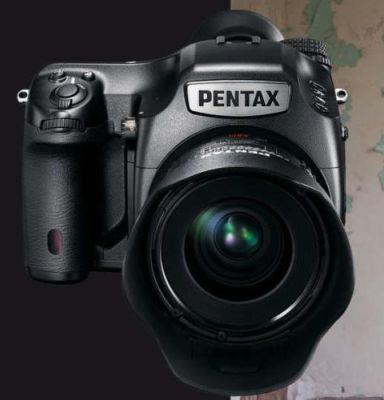
Pictured at left is the Pentax 645Z. This is a mirrorless medium format camera. It has a 51.4 megapixel sensor that measures 43.8mm by 32.8mm. It was preceded by the 645D, which had a 40 megapixel sensor instead, also the same size.
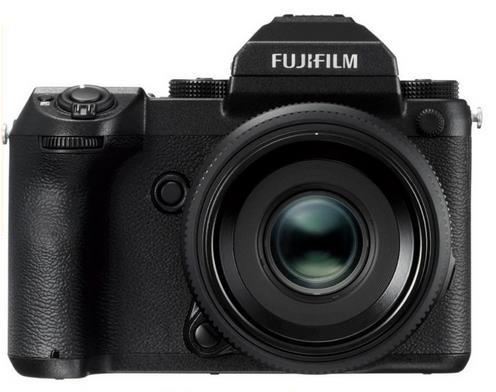
The Fujifilm GFX 50S, shown at right, had very similar specifications to those of the 645Z, a 51.4 megapixel sensor claimed as measuring 43.8mm by 32.9mm. It came out several months after the one from Pentax. The Fujifilm camera had a successor, the GFX 100S, with a sensor the same size, but having twice as many pixels. Like other Fujifilm cameras, it offers a number of film simulation modes, which allow the camera to make pictures resembling those made with various film stocks, from Fujifilm itself and from other makers, and this feature has made their digital cameras quite popular, as it is also available on their less expensive models. And Fujifilm has just now (September 2024) announced its successor, the GFX 100 II.
Incidentally, before it became possible to make oversized sensors for use on medium format digital cameras, some made do with full-frame 35mm sensors, and others, such as some digital backs for the Hasselblad, and the Leica S1 camera, used sensors that simply had a single line of pixels (or perhaps one for each of the three colors red, green, and blue) which were moved across the image area to acquire a whole image.
Oh, and incidentally, there is another medium format camera out there with a 100 megapixel sensor. In fact, the same company makes two of them.
Yes, I'm referring to the fact that now even Hasselblad has joined the mirrorless fray.
They have both the X2D camera, which is a conventional mirrorless camera with a 100 megapixel sensor, and they also have the same 100 megapixel sensor in the 100C back, which can be used with the Hasselblad SLR cameras, or with the Hasselblad 907X, which is a modular mirrorless camera unit which uses the same backs as Hasselblad SLR cameras.
So Hasselblad offers the choice of simply getting a straightforward mirrorless camera, or going mirrorless while retaining continuity with the Hasselblad medium-format SLR system. Of course, though, as the back focus is different, the 907X uses the same lenses as the X2D, not the same lenses as the Hasselblad SLR.
The Hasselblad H6D is a successor to the 907X, also using a digital back rather than having the sensor integrated as is the case with the X2D.
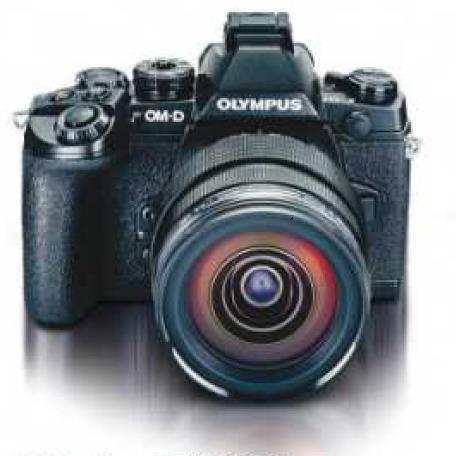
Pictured at right is another example of a mirrorless camera, the Olympus OM-D E-M1. This camera had a 16 megapixel sensor in the Micro Four-Thirds size (this has an imaging area of 17.3mm by 13mm); it was advertised as being everything that a professional photographer would need, and despite the existence of more expensive cameras with fancier specs, I feel this claim to have been quite justified.
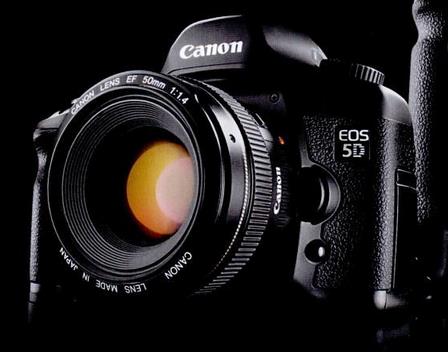
I mentioned that the Nikon D3 is available inexpensively on the used market. This is also true of another early full-frame camera, the Canon EOS 5D, pictured at left.
Most of these examples of digital cameras are still several years old, but they still give some idea of what photography is like today.
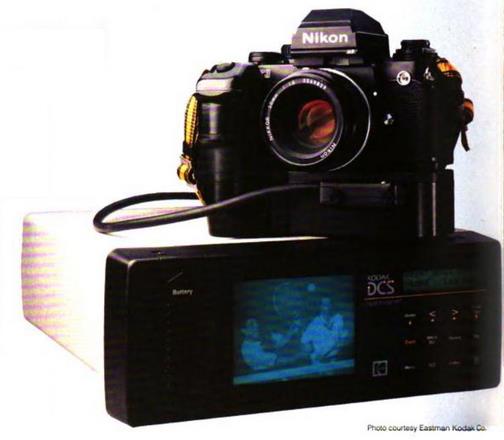
Although Kodak is closely identified with film, it did not neglect digital photography. In conjunction with NASA, it designed the Kodak DCS which was tested aboard the Space Shuttle in November, 1991. The camera is shown at right.
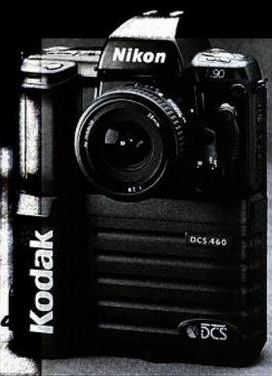
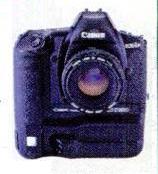
Kodak continued to use Nikon bodies in a line of professional cameras sold to serious photographers at relatively high prices, but then switched to Canon bodies. The Kodak DCS 460, using a Nikon body, is shown at left; the Kodak DCS 520, also sold by Canon as the Canon EDS 2000, is shown at right.
Since this camera was sold by Canon, presumably it was built around a Canon body, but I've learned recently that at least some of the digital SLR cameras sold by Kodak that used the Canon mount were built around camera bodies supplied by Sigma rather than Canon.
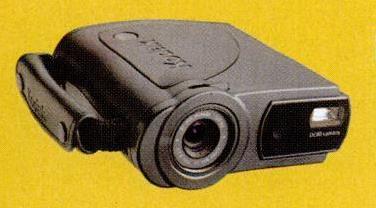
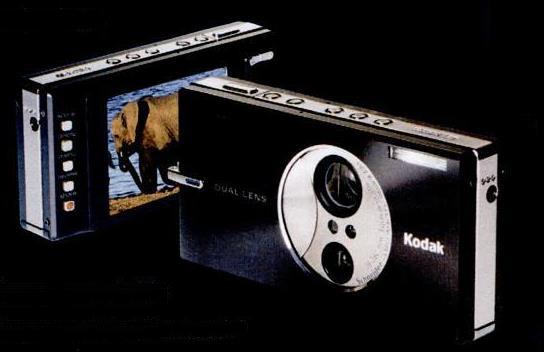
And Kodak went on to develop and offer for sale less expensive digital cameras to the general public. The Kodak DC 40 is shown at left; the Kodak V610, shown at right, was especially designed to work with a Kodak online service called EasyShare. It had a built-in zoom lens instead of interchangeable lenses.
I have seen an attempt to explain the downfall of Kodak on the basis that while it pioneered in the new realm of digital cameras, it lost sight of what ordinary people use photography for, and hence they didn't get the EasyShare service right. Obviously, it is true that they didn't collapse as the result of selling only film cameras while the world shifted to digital, but I cannot attest to the truth of the claim that EasyShare is the explanation.
Kodak's first camera to use their new APS film format had an unusual feature; it included a low-resolution digital sensor which recieved an image from the camera's viewfinder; parallax correction was done electronically before this preview image was displayed on the back of the camera.
Since the image came through the viewfinder, and not the camera's lens, and was low in resolution, it isn't quite accurate to say that buying an Advantix camera amounted to paying for a digital camera and then still having to pay for film, but it may have seemed that way to some consumers.
Also, although Kodak did involve itself in digital camera technology, it's also documented that in the years leading up to digital becoming dominant, the company's board of directors chose CEOs that viewed digital as the enemy, and sought to continue to build up Kodak on it's core strength of film. So there's hard evidence in favor of the "myth" that Kodak stuck with film when it should have been moving to digital; but if they lost precious time before digital took over, even if that meant their own digital cameras were "too little, too late", they should have been in an excellent position to play catch-up.
Of course, the Kodak V610 shown above is a point-and-shoot camera for the general consumer, and that market is the one that was eaten alive by the photography capabilities smartphones include. The digital cameras still around are DSLRs and mirrorless cameras also with interchangeable lenses and aimed at serious photographers. So one possibility I considered was that maybe family photography, which was in the past their huge market, instead of the niche market of professionals that was left to companies like Nikon and Canon.
Of course, if Kodak had brought out a digital camera that used the same lenses as the Kodak Retina Reflex S and the Kodak Instamatic Reflex, that would have been laughed out of the market instead of saving the company. But they weren't really in any danger of making that mistake.
Eventually, though, mulling things over, I think that I have finally found what was likely the culprit in Kodak's demise as a camera company.
What would it mean to "get EasyShare right"? I asked myself that question, and I encountered a statement that Kodak was a company based on the "razors and blades" idea.
Just like video game consoles are sold at a low profit, but the cartridges for them have a high markup, Kodak concentrated on making money from film and processing, selling cameras at low prices to generate demand for those items.
If EasyShare was to be a scheme to get people to pay Kodak money for every digital photo they took, I don't think that there was any scheme that they could have cooked up at Kodak that would achieve it. Of course, Instagram is a successful company; but it mainly offers a free service, and so Kodak would have had to ratchet down its revenue expectations significantly to succeed in that fashion.
So saying the reason Kodak failed was because they didn't get EasyShare right misses the real issue.
Kodak was stuck in the past about technology, focusing on film and neglecting digital. But that was at an early stage; while it lost them precious time, they changed course soon enough to participate in the market for digital cameras. They had plenty of resources with which to play catch-up.
But Kodak was also stuck in the past about their business model; since in the past their profits came from film and processing, they wanted a revenue stream associated with taking pictures, rather than one with the much rarer event of the sale of a camera.
And the biggest thing about digital cameras that makes them attractive to the general public is that you don't have to buy film and processing for them! Could Kodak have provided some type of hosting service for photographs that was so attractive that people would gladly pay for it?
So saying that their demise was because of not getting EasyShare right says that they failed because they were unable to do the impossible; instead, it's much more correct, in my opinion, to say that they failed by not realizing that continuing to derive profit from "blades" instead of "razors" was not going to be an option, and accepting that fact. That was the culpable failure; not achieving what can't be achieved is not something anyone can be blamed for.
I have recently learned that there is another important component to the near-demise of Kodak. One of the things Kodak did attempt as the decline of film became apparent was to diversify. However, it reversed course, and sold off business units it had created in its attempts to diversify. Fujifilm, on the other hand, made a success of diversification, and so it survives as a large company with large revenues despite the fact that its digital photography business is also much smaller than the film business it formerly had.
Fujifilm currently makes the Instax camera, which uses technology similar to Polaroid's to take instant photographs.
I've just found a web site where Kodak still advertises digital cameras, the Kodak Smile and the Kodak Smile+; all of the ones on that page have an additional feature - they print the picture that was taken instantly. Thus competing with Fujifilm's Instax without contravening the court judgement in the case sparked by the EK6.
So Kodak did not exit the digital camera field, and they're still focusing on products that give them an opportunity to sell blades instead of just razors! Except that apparently these cameras are not Kodak products, but products of another company (which I later learned was C+A Global, as they're also listed on Kodak's own web site) licensed to use the Kodak brand after Kodak really did completely exit the digital camera field. Is insanity contagious? Are the supplies needed to create those instant prints still made and sold by the real Kodak?
And whose idea was it to produce that kind of product in the first place? If the idea was Kodak's, that would make sense as coming from a desire to compete in every facet of the field of photography, even if vicariously; or was it just C+A Global seeing the success of Fujifilm's Instax, and concluding this was a valid market niche worth competing in?
Digital cameras that don't print out instant prints are also still sold by Kodak on their own web site, under the Pixpro brand name, but a footnote mentions that these products are sold and manufactured by JK Imaging under license, not by Eastman Kodak itself.
So my initial shock on encountering the Smile and Smile+ cameras, that led me to think that Kodak was clinging to the mistakes that killed it even in its afterlife, as it were, may have been unwarranted.
I have recently become aware of a new innovation in digital camera sensors, the dual-gain sensor. At first, I had a bit of difficulty understanding this innovation, as explanations of it did not clearly specify the reason that this innovation was beneficial.
One fundamental source of noise in a digital camera image is that the brightness of a pixel is determined by the nunber of individual photons that strike that pixel; this number is inherently a random value, varying around a mean deterimned by the ideal brightness of the pixel.
Amplifying the signal from the photodetector at a given pixel will only amplify this noise as well.
But this isn't the only source of noise in digital photographs. A digital camera, after all, has lots of electronics in it, including microprocessors. Amplifying a signal will make the signal stronger, relative to noise introduced from crosstalk, thus protecting the signal against this kind of noise.
However, one can't just design a camera sensor to apply a high level of amplification to the output of every pixel. A camera sensor is a microchip, and there are limits to how much voltage a microchip can handle. In fact, the maximum signal level in an electronic device is usually determined by the voltage of its power supply; this might be 12 volts, 5 volts, or even less in a system built around digital electronics.
This is where the dual-gain sensor comes in. The output from each pixel is sent out along two analog channels. One channel is the traditional one, where the maximum possible voltage, or a signal level slightly below it, represents the maximum possible brightness. This allows the analog signal to represent the scene being photographed without clipping, where brightness levels above a certain threshhold are not represented properly, because they've hit the voltage ceiling.
The second signal, however, is more strongly amplified, without worrying about clipping. That way, less-bright areas of the image can be converted from analog to digital using the second signal, in which the noise from crosstalk in the camera will be less significant.
Image files in a computer generally represent the red, green, and blue values of a pixel by 8-bit integers. RAW files in a camera, however, often use 10 or 12 bits each for red, green, and blue values. Dual-gain sensors have allowed cameras to have RAW files with 16 bits for each color value in a pixel!
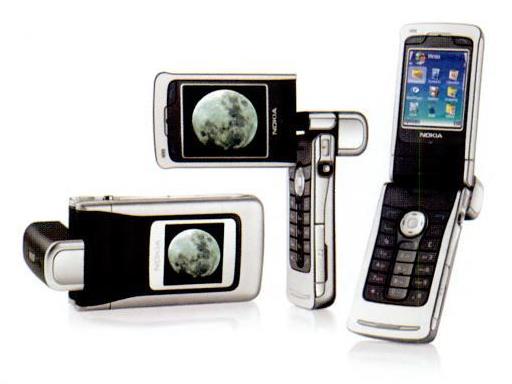
After almost wiping out film cameras, as has already been noted here, the digital camera faced stiff competition from the cameras included in smartphones; nearly everyone has a smartphone, nearly every smartphone includes a camera, and those cameras are now able to produce high-quality images.
This situation, of course, did not spring into being instantly. Thus, the Nokia N90 is pictured at left as an important stage in the evolution of cell phones with cameras. This picture, from an advertisement, shows the Nokia N90 in three different articulatiions in an effort to convey the phone's configurability.
In order to fit a camera into the very flat body of a smartphone, a lens system including highly aspheric components is required. If you wanted to add a camera to a cell phone before this technology existed, you might end up with something like the Nokia N90.
Basically, the Nokia N90 is a flip phone. The top half, with the screen, is divided into two parts, so that a small part under the screen is connected to the main hinge of the phone by means of which the phone is flipped open, while the part with the screen is free to be rotated.
When the phone is closed, the camera lies on top of the hinge. It, too, can rotate. By giving the width of the phone to the camera as its depth, a conventional lens - in this case, supplied to Nokia by the illustrious optical firm of Carl Zeiss - has room to exist and bring light to a focus on an image sensor.
Thus, on the right of the image, we see the Nokia N90 open, as a normal flip phone, for making phone calls or using the applications on the phone.
On the left of the image, the phone is closed. On the back of the display, there is a smaller screen available for use when the phone is closed - and it's available to use as a viewfinder for the camera, which is rotated to point forwards, away from the viewer.
In the center is shown another way of using the camera; rotate the main screen, and use it as the viefinder with the phone open; the camera doesn't need to be rotated here.
In looking for information on unusual cameras, I learned about a new kind of camera, the Lytro. It was said to operate by recording both the direction and position of photons coming from a subject. And so one could take a picture, and then choose afterwards what distance to focus it at!
I didn't think that the technology existed yet to do such a thing, except through such means as holography, which still requires film.
Looking into the subject of what are called "plenoptic cameras", though, I found that what seems to be happening is that while it isn't possible to record a complete "light field", faking it is possible and useful.
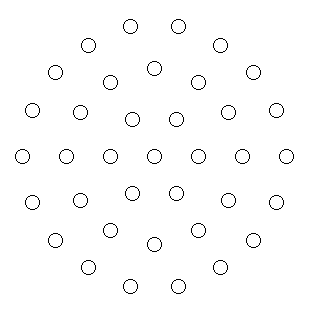
Suppose one has an array of tiny digital cameras, each one stopped down, say, to f/32, so that they all capture images with a large depth of field. They are all focused at the minimum distance that allows infinity to be in sharp focus.
The image at left shows one possible layout of such an array; one central camera, with three concentric circles of cameras, equally spaced, around it.
Since there aren't as many cameras as there are pixels in the sensor of a typical camera, obviously this has no pretensions of actually recording a real light field.
But if you superimpose the images from all these cameras, by choosing the size of the displacement used for the images from each successive ring, you can determine at what distance from this array of cameras the objects the images of which are correctly superimposed lie.
So such an array of cameras allows after-the-fact focusing. The blur of out-of-focus objects isn't continuous; it results from the superimposition of 37 equally-spaced discrete images of the object.
If you have software that recognizes objects in images, it could be used to allow information from the other cameras to be added to the picture taken by the central camera, thus reducing the noise level in a picture intended to be in focus at all distances.
This scheme could also be used to superimpose images only from the central 19 cameras, or the central 7 cameras, using the cameras in the rings further out as sources of additional light from objects, so as to allow varying the depth of field after the fact to intermediate values.
That kind of software could also apply a continuous blur effect to areas of an image created by superimposition where the objects are to be out of focus.
These pages, while they examine cameras of several different types, concentrate mainly on the 35mm SLR.
We have seen above why the first 35mm SLRs generated some excitement, being small and light, and therefore more convenient, and why the pentaprism was a very important development, since it made looking through the viewfinder simple, and similar to the way it was with other types of camera.
But another question hasn't been addressed above at all. In a digital camera, one can view the scene the camera is looking at through a display on the camera. Why do digital SLRs even exist at all?
However, this question wasn't always applicable. Because CCD sensors consume more power than CMOS sensors, live preview was a feature that was often not available on earlier CCD-based DSLRs, which meant that the SLR camera format was obviously valid for the same reasons as for film cameras.
Also, the digital display on a camera had originally been much lower in resolution than the camera's digital sensor. As well, one film SLR feature not discussed above is that the ground glass in a film SLR usually has a central region with special features designed to aid in focusing the camera. This is one reason why some of the most high-end cameras had removable pentaprisms, because there was a reason why someone might wish to swap out the ground glass plate for one where these special features were differently designed.
So the DSLR did have practical benefits for manual focusing, in addition to fitting in with what people were used to.
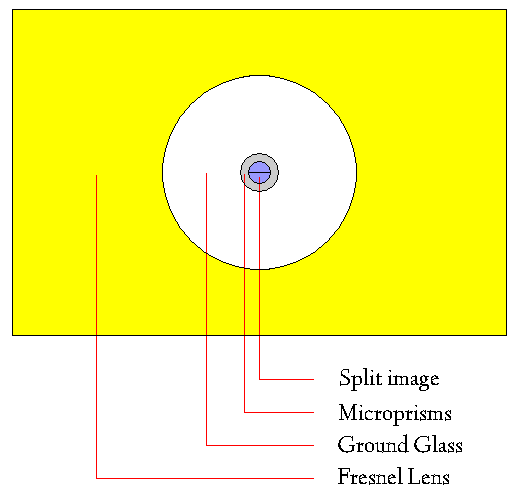
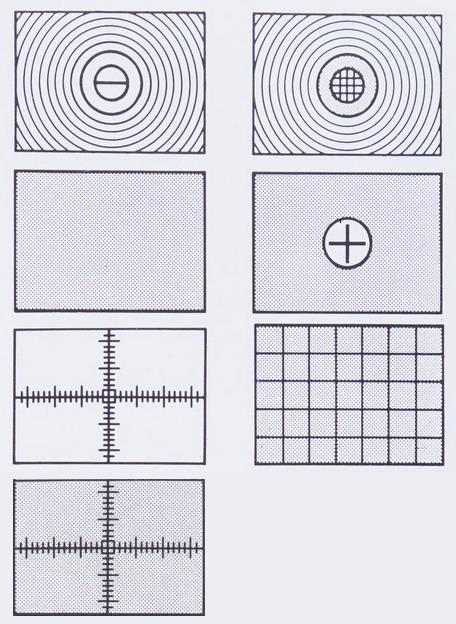
Shown at left is a diagram showing the elements of one type of focusing screen. In the center is a small circular area divided into two halves, where the surface of the screen on one side is tilted to the left or right, forming two prisms, which will split vertical lines that are not focused properly.
The next ring outside the center consists of microprisms. A similar principle is involved as in the split image area, but here small prisms in multiple directions mean that only items in focus can be seen clearly.
Then most of the central area consists of a plain ground glass surface, where the image can be seen as it will be, whether in or out of focus, with the out of focus areas simply being blurred as they will be in the final image.
The outside area instead is a Fresnel lens, acting as a field lens, to make the image as bright as possible, although this means that in this area, it is not possible to tell anything about whether items are in or out of focus.
The most common focusing screens on single-lens reflex cameras are of this general type, although they usually omit the split image area, having only microprisms in a central circle.
But optional focusing screens can be of other types; for example, they might consist entirely of plain ground glass, possibly with a reticle pattern marked on the screen as well. At right are shown the seven types of focusing screen available for the Praktica VLC camera; the top row shows a Fresnel lens combined with a split-image rangefinder and then a Fresnel lens combined with microprisms instead. The second row shows a plain ground glass screen, and a ground glass screen with a clear spot with crosshairs. The third row shows a clear screen with a millimetre (on the film) scale, and a ground glass screen with a grid. And the bottom row shows a ground glass screen with the same type of millimetre scale as shown above on a clear screen.
Given, however, that not only do digital SLRs not have interchangeable focusing screens in general (although there were a few exceptions; the early Kodak digital cameras built around the Nikon F5 body would of course have had interchangeable focusing screens as well as a removable pentaprism, and even the much later Nikon D200 can have its focusing screen replaced by going through the lens opening and using tweezers and a special tool that came with the camera), but that their focusing screens are plain ground glass screens without focusing aids such as microprisms or a split prism section, I suppose it's little wonder that the major camera makers have abandoned making new DSLR designs, and have instead restricted themselves to mirrorless cameras in future:
SONY's Alpha 68, announced on November 5, 2016 was their last DSLR design.
The EOS-1DX Mark III was Canon's last DSLR design, this camera having been announced on January 6, 2020.
The Nikon D6 came out a bit later, in June 2020.
While no new DSLR designs would be made, the existing designs would continue to be sold and manufactured.
SONY, in May of 2021, was the first to discontinue its existing DSLR products.
On the other hand, Pentax is still rumored to be coming out with a Mark III version of its K-1 DSLR. However, these are just rumors, and there are indications that this is unlikely, because Pentax hasn't been coming out with new DSLR models or technology of late. The K-1 is the full-frame DSLR to which, because it uses the K-mount, M42 screw-mount lenses can be properly adapted.
Incidentally, while Nikon's current mirrorless cameras use APS-C or full-frame sensors, they also, at an earlier time, starting in 2011, made a line of less expensive mirrorless cameras which still had interchangeable lenses. These cameras, such as the Nikon 1 J1, used the small CX sensor format, only 8.8 mm by 13.2 mm.